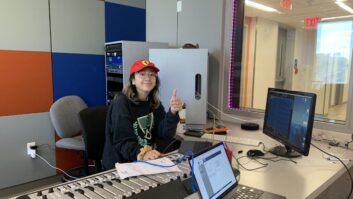Radio World publishes User Reports on products in various equipment classes throughout the year to help potential buyers understand why a colleague made a given equipment choice. These are unpaid testimonials by users who have already purchased the gear. A Radio World Product Evaluation, by contrast, is a freelance article by a paid reviewer who typically receives a demo loaner.

Engineer Evan Stanek teaches morning announcer Doug Erickson about the AVFleX Segue Editor. APPLETON, Wis. — Changing the audio playout system in a cluster of radio stations is the type of project that gives pause to even the most ambitious broadcast engineer. No other system affects as many departments, touches as many individuals or affects the final on air product as much. Woodward Radio Group has a cluster of six stations operating in the Appleton/Green Bay, Wis., area. Since 1995 the stations have been using a Broadcast Electronics AudioVault AV100 system with software versions 5.x through 8.x.
This system had grown as more stations, studios and functions were added. The AV100 system was running reliably but it was getting more difficult to support the hardware and software. AV100 was developed in the early 1990s using technologies common at the time like SCSI drives and ISA cards. Even though that is only 20 years ago, it might as well be centuries when dealing with computer hardware and software.
New system
Broadcast Electronics had introduced a newer hardware platform with AV2 (Version 9.x) that relied on more modern software, hard drives and audio cards a number of years ago.
We had been planning to upgrade our system to AV2 but we had a large investment in our AV100 and it was running reliably, so the project was put off repeatedly.
In 2009 we felt we had to complete the project and company leadership agreed. The replacement system was planned and budgeted based on the AV2 framework.
Once the equipment arrived and installation began, we were approached by the installation team at Broadcast Electronics: Did we want to install the conventional product (AV2 Version 9.2x), or would we like to consider moving to the next generation, the soon-to-be-released AudioVault FleX? What a decision. Broadcast engineers love reliability, so a major negative would be to run something so new in a critical application. I do not like to run “version dot zero” of anything.
But there were some compelling arguments to choose AVFleX. The software had been in test at prominent stations for almost a year already; we would not be the first. And if we could pull this off, we could avoid a future platform upgrade cycle and those additional costs.
BE felt that we were a good candidate to try FLeX because we had two sharp young engineers on staff to help support the new system. Evan Stanek had been with us for four years and knew our operation well; he was selected to be the lead installation engineer for the system. And we were fortunate to have newcomer Mike Steele available. He could add user support of the system to his experience and other work as PC help desk support. These guys, plus good support from our vendor and our corporate IT department, gave me confidence that we would be able to handle any challenges. The first thing we noticed is that the FleX system had more choices in how the on-air machines could be configured.
The traditional AV Air screen was now split into two separate applications, the “engine” that actually is playing out the schedule and the “user interface” that the announcer is manipulating.
Also, the user interfaces could be customized much more than the earlier versions of AV Air. At installation time there were three completely different screen appearances or “skins” to choose from, with the promise of more. Our program directors selected the “Touch” interface. Each skin can be customized to individual announcers or programs.
There are several advantages to the architecture, one being that if an announcer should lock up the user interface PC, this would not cause an on-air disruption. The separate audio engine PC will continue to play the schedule until the problem is resolved. Also, it’s easier to set up a hot standby audio engine with automatic failover.
From nine to two
Audio files can reside in multiple locations, like both of the AV servers, both audio engine PCs and the emergency backup workstation; so a disk failure would be only a minor inconvenience until repaired, then the audio files will quickly copy over. AV2 users had been used to this, but we were experiencing this benefit for the first time.
Our “playout system” server count dropped from nine dedicated AV100 servers to two dedicated AVFleX servers. Our two servers handle audio for the four production rooms and keep redundant copies of all system audio files for six radio stations on each server. The servers primarily handle synchronization of audio files and schedules, and other tasks.
If a server should fail, it will not immediately affect the audio output on any one of the six stations, because each station is delivering audio locally from its group of workstations and engines. However, the broken server would need to be repaired promptly, because some production room audio would be out, and future days’ schedules would also soon be affected.
Voice-tracking is another major improvement. It used to be done in AV Scheduler, using three audio channels. In AVFleX, voice-tracking is done in a new program called Segue Editor, a standalone application which looks directly at the schedule database and requires only one audio input on the studio console.
With the vastly different interaction between machines, the new system has many more software “modules” running on the PCs than what we were accustomed to. AudioVault veterans will recognize newer versions of applications like AV Time, AV Scan and NF Server. These are joined by new applications to keep everything running and talking to other machines like AV Watchdog, AV Log Sync and AV Harmony.
Other applications running on the FleX system are similar to earlier versions. We were able to install and program AV RPS, AV Sat and AV Net much as we did before with virtually no learning curve.
Separate network
Our AVFleX system is on its own dedicated local-area network and completely separate from the main business LAN. To keep things clear for all engineers, we used a separate Cat-5 wire color to emphasize the separate AVFleX network.
One of the problems with the old AV100 system is that over 15 years it grew from a couple of workstations and a server on our business LAN to a monster system of 60 workstations and nine servers. This had its own set of problems. But at least we never had to worry about a virus bothering the audio on the old SCSI drives! Using a newer-style system with WAV and MP3 files meant we had to pay more attention to system security. Now any traffic that has to come from the existing business network must pass through a Cisco ASA firewall. We are glad to get the new system off the business LAN and onto its own dedicated network.
This facility also has the beginnings of an extensive Axia Livewire network. WAPL’s control room and Production Studio 4 have Axia Element consoles. When interfacing to these rooms, we used the Axia Livewire drivers on the AVFleX workstations, eliminating the need for the professional sound card on those PCs. At this writing we are still troubleshooting some issues with certain AVFleX applications and the Livewire drivers, but overall that portion of the installation process was smooth.
The system has been continuously on air since July, and results have been better than what I had expected. Any new software will have issues and some “undocumented features” (bugs). But problems have been few, and the people at Broadcast Electronics have been responsive in addressing questions. They are giving a lot of attention to anything we find in the field. I am very pleased that we selected the AVFleX for our radio stations.
The author is director of engineering with Woodward Radio Group.
For information, contact Tim Bealor at Broadcast Electronics in Illinois at (217) 224-9600 or visitwww.bdcast.com.












